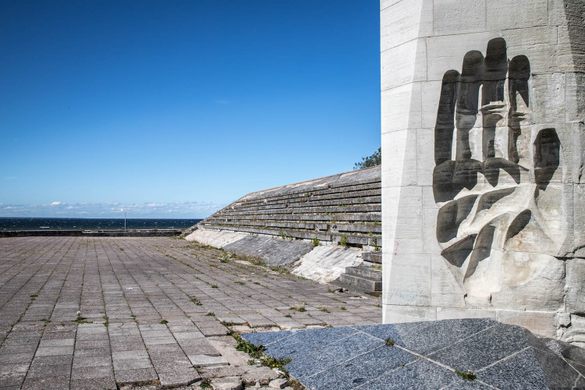Maarjamäe Memorial Complex
This striking memorial is one of Estonia’s most controversial Soviet leftovers.
In 1960, an obelisk was raised beside the sea in Tallinn’s subdistrict of Maarjamäe (which in Estonian means “Maria’s Hill”). It commemorated the Bolshevik victims of the 1918 Russian Civil War, part of which played out here when Allied nations intervened against the Bolshevik forces in the Baltics. The obelisk was designed by architect Mart Port, one of the authors of Tallinn’s Modernist Väike-Õismäe district, along with the sculptor Lembit Tolli.
That obelisk alone was already controversial. The Bolsheviks had actually been fighting against Estonia during the conflict it referenced, and numerous memorials to Estonia’s own dead were removed during the years of Soviet occupation. Nevertheless, in 1965, a decision was made to expand the memorial complex at Maarjamäe, and an architectural competition was announced.
The winning design was created by the architect Allan Murdmaa, along with sculptor Matti Varik, and consisted of a number of interconnected symbolic structures: the preexisting 115-foot (35-meter) obelisk would be joined by memorial graves for the crew members of the destroyers Avtroil and Spartak, which had served the Bolshevik-controlled Baltic Fleet during the Russian Civil War, while a series of sculpted iron and concrete figures memorialized the Soviets who fell against Nazi forces from 1941 to 1944.
The construction of the new memorial complex was overseen by the architects Allan Murdmaa, Valve Pormeister, and Henno Sepmann. It was completed in 1975. At the sea end of the complex, a symbolic amphitheater overlooks the road to Pirita and offers a dramatic panoramic view over Tallinn Bay. An “eternal flame” occupied a corner of this space, surrounded by evocative hand-shaped reliefs.
A long corridor framed between landscaped banks leads away from the water, inland toward the memorial graves, its exaggerated length presumably designed to provide space and time for reflection. Bisecting this pilgrimage path meanwhile, a perpendicular route cuts across and leads through a crooked gateway formed between faces of white dolomite stone. Above the path, an abstract bronze sculpture titled “Perishing Seagulls” seems to depict wounded birds in chaotic flight.
Since Estonia gained its independence from Soviet rule in 1991, the Maarjamäe Memorial Complex has faced an uncertain future. Its symbolism goes beyond being merely pro-Soviet, to being, arguably, even anti-Estonian in meaning; celebrating the Bolshevik troops who died fighting against independent Estonia in 1918, while featuring the graves of crewmen from two Russian battleships that had been shelling the port of Tallinn during the conflict.
The memorial complex is notably free from vandalism or graffiti, though neither is it maintained; just recently, the amphitheater has been fenced off against visitors over fears of structural instability. Meanwhile, some efforts have been made to address the balance of history. In 1998, the city partially restored the former German war cemetery that was originally set here in 1941, and contained some 2,300 internments before the Soviets built over it. More recently, Tallinn established a new counter-monument nearby: the Memorial to Estonia’s Victims of Communism, opened in 2018, to remember the 75,000 people—20 percent of Estonia’s population—who were killed during the years of Soviet occupation.
Know Before You Go
The Maarjamäe Memorial Complex overlooks Tallinn Bay from its location on Pirita Road, east of the city center. The recent opening of the nearby Memorial to Estonia’s Victims of Communism gives visitors even more reason to make the trip out here, the two memorials between them providing a multifaceted reflection on Estonia’s 20th century history.






















Follow us on Twitter to get the latest on the world's hidden wonders.
Like us on Facebook to get the latest on the world's hidden wonders.
Follow us on Twitter Like us on Facebook